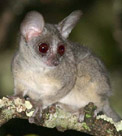Get
To Know
|
 The
Senegal Galago, or the lesser bush baby, is a small (130mm and 95-300
grams) nocturnal primate. They are agile leapers, and live in dry woodland
regions and savannah regions of Africa south of the Sahara. They have
woolly thick fur that ranges from silvery grey to dark brown. They have
large eyes, strong hind limbs, and long tails, which help them balance.
Their ears are made up of four segments that can bend back individually,
to aid their hearing when hunting insects at night. Their omnivorous diet
is a mixture of other small animals, including birds and insects, fruit,
seeds, flowers, eggs, nuts, and tree gums.
They are polygynous, and the females raise their young in nests made from
leaves. They have 1-2 babies per litter, with gestation period being 110–120
days. Bush babies are born with half-closed eyes, unable to move about
independently. After a few days, the mother carries the infant in her
mouth, and leaves it on convenient branches while feeding. At the end
of the night, group members use a special rallying call and gather to
sleep in a nest made of leaves, in a group of branches, or in a hole in
a tree. Their potential predators include mongooses, genets, jackals,
domestic cats and dogs, raptors (especially owls), and snakes. In addition,
several primates, including humans, Grey-cheeked mangabeys, blue monkeys,
and chimpanzees, who have constructed spears, sometimes prey on bushbabies. The
Senegal Galago, or the lesser bush baby, is a small (130mm and 95-300
grams) nocturnal primate. They are agile leapers, and live in dry woodland
regions and savannah regions of Africa south of the Sahara. They have
woolly thick fur that ranges from silvery grey to dark brown. They have
large eyes, strong hind limbs, and long tails, which help them balance.
Their ears are made up of four segments that can bend back individually,
to aid their hearing when hunting insects at night. Their omnivorous diet
is a mixture of other small animals, including birds and insects, fruit,
seeds, flowers, eggs, nuts, and tree gums.
They are polygynous, and the females raise their young in nests made from
leaves. They have 1-2 babies per litter, with gestation period being 110–120
days. Bush babies are born with half-closed eyes, unable to move about
independently. After a few days, the mother carries the infant in her
mouth, and leaves it on convenient branches while feeding. At the end
of the night, group members use a special rallying call and gather to
sleep in a nest made of leaves, in a group of branches, or in a hole in
a tree. Their potential predators include mongooses, genets, jackals,
domestic cats and dogs, raptors (especially owls), and snakes. In addition,
several primates, including humans, Grey-cheeked mangabeys, blue monkeys,
and chimpanzees, who have constructed spears, sometimes prey on bushbabies.
|
|
|
|
Before they leveled the playing field
one side was always running uphill,
which was hard. And the other side
was always running downhill, which was
hard too--hard to stop the ball from rolling,
hard to stop yourself from running
when you're running down a hill after a ball.
Downhill had certain advantages though.
It was true. But uphill had advantages too--
you could belay; you could stick a strategic
foot out, trip a careening downhill guy
mid-stride. And anyway, we usually
switched at halftime. So when the referees
came up with the idea, we scratched our heads
and tried to envision a playing field that was
level. "You mean get rid of the hill?" we asked
incredulously. They nodded vehemently
and their excellent silver whistles hanging
on lanyards round their necks bobbed in sympathy.
The bulldozers and the backhoes arrived
the next day, the tines of their buckets biting
into our hill, eating it away before our eyes,
and before we could say time out, or foul play,
or off sides--which some of us did say, although
by then it was too late--they'd gone and changed
the game forever. Some of us quit outright, preferring
to sit in judgment up in the stands--the closest
thing to a hill that they had. And some of us kept on playing,
adapting ourselves to the changing landscape,
learning the new steps, and the new names, making
new friends, many of whom were so young that
they'd never played on a hill. They could only
imagine, they said. They could only shake their heads
and regard us in a squinting sort of way, as though
the sun were going down behind a hill, behind us.
Paul Hostovsky is the author of three books of poetry, Bending the
Notes, Dear Truth, and A Little in Love a Lot. His poems
have won a Pushcart Prize and been featured on Poetry Daily, Verse
Daily, The Writer's Almanac, and Best of the Net 2008 and
2009. To read more of his work, visit him at www.paulhostovsky.com.
|
 The
Senegal Galago
- Issue Eleven
The
Senegal Galago
- Issue Eleven